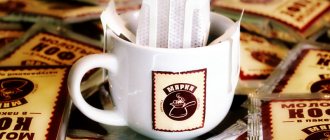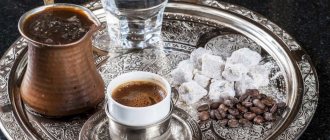Legends of the origin of coffee
Today there is no clear truth about the origin of coffee, we know that the origins of the homeland lie in Ethiopia, and there are several versions of its discovery, but there is one that I want to retell, about the shepherd Kaldi. It sends us back to the middle of the 9th century, where we first learned about the miracle of berries that give an unprecedented supply of vigor. At first, it was not people who recognized the remarkable effect, but goats, who turned out to be more inquisitive, and their shepherd, whose name was Kaldi, noticed the consequences. He noticed that after eating the berries, his goats became cheerful and began to jump wildly. Then he took the berries to the local monastery, where the monks tried them, and, having convinced themselves of the effect, began to use this decoction so as not to fall asleep during long night services.
There is also a well-known fact that during this period one of the African tribes used coffee berries with fat as an energy food, which adds credibility to this legend.
Classification[edit]
Next, samples are taken from each delivery bag.
After sampling, coffee from different shipments is put together and further processed to improve quality. The product passes through a cleaning machine, then through a mechanical screen that separates the grains by size, and then they are transferred to a vibrating table that sorts them by weight. After this, the product is sent to an electronic separator, which removes black and green beans that spoil the taste of the brewed coffee. Whatever is left goes into a storage tank and is bagged. The bags store grains of uniform size and quality, which can be exported or sold to local buyers.
Samples taken earlier are classified to determine the price of the product. First of all, the samples are divided into types based on the number of defects in 300 grams of coffee. Defects include black, green and broken seeds, as well as husks, sticks and pebbles. The grains are then sifted through several sieves and distributed according to size.
Finally, the coffee is sent for tasting. The sample is lightly fried, crushed and placed in several glasses in measured portions. Boiling water is added, the contents of the glasses are mixed, and an experienced taster evaluates the smell emanating from each sample. After allowing the sample to cool and the coffee particles to settle, he scoops some up with a small ladle, takes the coffee sample into his mouth, immediately spits it out and quickly moves on to the next glass, where he repeats everything all over again. Having tasted all the samples, he gives the coffee different ratings: from “soft” (pleasant, tart, almost sweet) to “hard” (with a sharp, iodine taste).
To accurately identify many subtle flavors, the taster must have a delicate taste, extensive knowledge and extensive experience. The results of the tasting not only serve as the basis for determining the price, but are also important in the next stage of producing high-quality coffee.
Origins of cultural coffee consumption
What they didn’t do with coffee: they used it in medicine as a medicinal plant, soaked it in cold water for coffee decoctions, mixed it into food with fat, but they started frying and grinding only in the 13th century, at least the first mentions date back to this time . During that period, with the growing influence of Islam in the east, many began to follow Muhammad’s ban on wine and other alcohol, and coffee became an excellent alternative, which would later be called “Arabian wine.” By the way, the Arabian Peninsula gave Arabica coffee its legendary name.
Cold water for coffee
In Ancient Greece, a tradition arose: when treating a guest to invigorating coffee, he was immediately given a glass of clean cold water. Thanks to this combination, the taste of coffee blossomed with a magnificent bouquet after a sip of water. Gradually the ritual migrated to Turkey, and then spread to different countries.
- Water washes the taste buds in your mouth from leftover food and other drinks.
- Water washes away coffee stains from the surface of the teeth, eliminating yellowing of the enamel.
- Water prevents dehydration that can occur from consuming large amounts of caffeine.
- Many coffee lovers like the unusual combination of cold and hot.
- Water softens the coffee bitterness.
Important! Before serving, the water must be filtered so that it is completely free of chlorine and has no odors. Some gourmets prefer to add a small slice of lemon to a glass of cold water.
The popularity of coffee is getting higher every year. Instead of tea, more and more people prefer an aromatic and invigorating drink. It has many faces, many facets and is unique for every coffee lover!
Return to list of publications
The origins of coffee as a business
The Muslims quickly realized that coffee would become an important export commodity and took control of it, which remained with them for 300 years. They took maximum measures to remain a monopoly: they strictly protected coffee plantations and prohibited visiting them, did not allow the export of coffee trees, and when exporting green raw materials, they scalded it in boiling water or partially fried it. Arabia became the only place in the world where coffee could be bought, and Turkey by the 15th century became the world's main distributor, conquering the markets of Persia, Yemen, Syria, Egypt, Greece, and by the 16th century it was already supplying coffee to Italy. By the way, the appearance of coffee in Italy was controversial; Catholics believed that it was the drink of the devil and petitioned Pope Clement to ban it. The pope wanted to approve the petition, but first try what he was going to ban. Having taken a sip, he immediately christened it, saying that the drink was too good to be drunk only by the Turks. So coffee was approved in Christianity.
Composition, benefits and harm
Scientists have discovered more than a thousand different chemicals and compounds in coffee, many of which are very beneficial for our health.
Even without the ability to make such assumptions, ancient doctors saw coffee as an excellent medicine.
It is believed that the peak of popularity of grains in this capacity occurred in the 16th century: in England, potions were prepared from medicinal grains, combining coffee with another valuable product - honey.
In one cup of coffee, modern science identifies the presence of three hundred different antioxidants that can remain in the body and work for its benefit for a month.
Californian scientists have conducted research according to which even the steam rising from a mug of hot drink already contains as many antioxidants as there are in three citrus fruits.
Useful information for those losing weight - there are no calories in a serving of black coffee (without sugar).
Coffee contains elements that do not allow harmful bacteria to linger on tooth enamel, thanks to which coffee lovers are less likely to suffer from tooth decay.
In 2003, a group of Neapolitan doctors tried to accuse coffee of negative effects on the nervous system, heart, and other organs through the courts. However, the drink beloved by many was justified.
But athletes need to be careful with coffee: the IOC considers caffeine (and what invigorating drink can do without it!) as an unacceptable drug.
Disqualification will follow if more than 12 micrograms of this substance per 1 liter is found in the athlete’s urine.
Coffee has a property that some will consider a benefit, while others will consider it a disadvantage. The fact is that this drink helps a person accept a statement with which he previously did not agree.
In any case, if your opponent invites you for a cup of coffee, think about whether you need it or not.
The first coffee shop in the world and its followers
The first coffee shop in the world opened in 1475 in Constantinople, now the capital of Turkey - Istanbul. The Turks have made a significant contribution to the development of world coffee culture, including consumption, because until now, Turkish coffee is one of the most popular ways of brewing at home.
At the beginning of the 16th century, the door to Europe opened for coffee, and by 1670 coffee houses had appeared in almost every major city, and European countries adapted this phenomenon into culture in different ways:
- In England, coffee shops became a place where pressing issues of the day were discussed, a kind of public forum; they were also called “penny universities,” since anyone with one penny could buy a cup of coffee and join the discussion. Women were not allowed into these coffee shops, which was the beginning of protests, since men spent a lot of time in them. The protests were unsuccessful, and by the end of the 16th century there were about 300 coffee houses in London.
- In France, on the contrary, coffee culture took a different path, these were places where men and women met, there was a rich interior around them, and musicians played. It was here that coffee with milk, which the French called café au lait, first became popular.
- In Italy, the first coffee shop appeared in 1647, in Venice. It was the Italians who in the 20th century invented the espresso coffee machine, which would become a revolution in preparation and form the basis for everyone’s favorite coffee recipes: cappuccino and latte. By the way, many people believe that coffee itself grows in Italy. This is a misconception, they make good equipment for its preparation, and we will tell you where coffee grows and its current geography in the following articles.
- In America, the first coffee shop opened in Boston in 1670, but Americans drank more tea than coffee. Everything changed in 1773, when the Boston Tea Party occurred, it was a protest against an increase in the tax on tea by England. This was the turning point when Americans abandoned tea in favor of coffee, after which it became the national drink here too.
Project on the topic “Tea drinking traditions in different countries”
Introduction
For most of us, drinking tea is not just a meal, but a kind of ritual. A cup of tea, drunk alone, can calm you down and make you forget about minor problems. Tea drunk in company creates a joyful, friendly atmosphere. And tea, shared between two, can even rekindle faded feelings. But what do we know about tea? In fact, nothing...
Perhaps no product has been studied as closely as tea. Tea leaves have been used by humanity for 3,000 years as a cure for many diseases, and only recently has tea become an everyday drink. In the homeland of tea, China, this drink is still treated with respect and drunk for the treatment and prevention of diseases, to strengthen the immune system, for vigor, for inspiration, and for relaxation. In solving almost any problem, the first step is tea.
Each country has its own traditions of drinking tea, which have developed historically. This drink is considered the most popular in many countries of the world. The tea ceremony is an exquisite ritual. If a person likes to travel, he can compare the taste of a classic tea drink in different countries.
Objective of the project
– study tea drinking traditions in different countries.
Tasks:
1. Collect information about common tea drinking traditions.
2. Study information about rare tea drinking traditions.
3. Conduct a survey among students of Municipal Budgetary Educational Institution “Secondary School No. 2”.
4. Create a guide to countries around the world with their tea drinking traditions.
Methods:
— search
- comparative
- generalizing
- analytical
Practical significance
is that the guidebook I created can be used as a socially significant product.
The history of tea: myths and reality
Traditionally, China is considered the birthplace of tea. The Chinese first mentioned tea bushes 4,700 years ago. For quite a long period of time, China was the only tea producer in the whole world. However, over time, thickets of tea bushes began to be found in India, Vietnam, Laos, in the foothills of the Himalayas and other places around the world. The British, Portuguese and Dutch began to import tea into Europe starting from the mid-17th century.
Legends attribute the discovery of tea to the mythical Chinese emperor Shennong, who allegedly lived in 2700 BC. e. This wise ruler drank only boiled water. One day, at a rest, leaves of an unknown bush fell into his pot, and the water acquired such a fresh, invigorating taste that the emperor ordered the plant to be planted in the palace garden and named it “cha,” which means “fresh.” In the southern Chinese dialect, this word sounds like “te”; it later turned into the European “tea”, “te”, and the first version gave the name to the Russian “tea”.
But this version is not very plausible, since tea in China has long been considered a common drink. It was believed that it helped against “72 poisons,” even such as “weakness of spirit,” “hard heart,” and “poison of laziness.” In addition, he saved from hunger. Tea leaves were made into cakes, lightly fried, and then poured with boiling water. After that, salt, onion, ginger and other spices were added - the result was tea soup.
Tea became a popular drink among the nobility only in the 7th century, thanks to Buddhist monks who drank it during night prayers in order to stay awake. This was told in the “Canon of Tea”, the first book in the history of mankind about an invigorating drink, by the Chinese saint Lu Yu. He wrote that tea should be drunk by “people of refined manners, modest and friendly.” In those days they only drank green tea.
The spread of tea around the world began much later - around the 5th century AD, when the Chinese began selling it to the Turkic tribes. Another 200 years later, tea firmly entered the life of the nomadic peoples of the Great Steppe and the Tibetans. It took another 200 years for tea to become the national drink in Japan.
Europeans were able to try tea only in the 16th century, and really tasted it even later - a century later, when the Dutch began to bring commercial quantities of “Chinese herb” to the Old World. In 1664, the English East India Company presented King Charles with two pounds of tea as a gift, and from that time on, tea conquered Foggy Albion. Tea shops appeared, and in 1717 the “Golden Lion” tea house opened in London.
Tea traditions: England
Traveling around the world, tea drinking culture developed and changed, sometimes acquiring the most bizarre forms. It’s hard to believe, but the most tea-drinking nation in Europe was at one time the last to learn about the existence of tea – but that’s exactly the case.
The damp English climate literally encourages the British to love tea. Every day the population drinks more than 12 million cups of aromatic tea, accompanied by all kinds of treats. English tea drinking is not just a tradition, but a national need that is satisfied at the highest level.
The British have been drinking tea since the mid-17th century, rightly considering it a source of vigor and optimism, good immunity and peace of mind. The healing properties of the drink are greatly enhanced by heated milk, which is poured into a cup before adding steep tea leaves or boiling water. Initially, this method of brewing was necessary so as not to damage expensive porcelain. Then the tradition took hold - people liked the combination of tart tea leaves and delicate milk.
Six cups is the daily minimum prescribed by the English tea tradition. Drinking tea on a schedule is quite in the spirit of the British people. There are six most preferable periods for drinking tea:
- Morning tea - cheerfulness in bed. The British try to drink their first cup of tea immediately after waking up, often without even getting out of bed. 70% of the adult population wakes up around 6-7 am, trying to start the day sedately, without haste. Teas with a mild taste but strong aroma are selected. Fruit mixtures, herbal and green teas are preferred.
- Tea for a light breakfast. The first breakfast in England takes place around 8 am and is accompanied by a special “English Breakfast” tea, which is a mixture of several types of strong black tea (Assamese from India, Ceylon from Sri Lanka, Kenyan from Africa). Large twisted leaves form a strong drink that can quickly cheer up the sleepiest person.
- Tea lunch. The British try not to skip lunch and willingly treat themselves to a cup of aromatic tea. The second breakfast usually takes place around 11-12 o'clock and is characterized by an abundance of food and delicacies. Usually lunch takes place outside the home, so it can be difficult to brew loose leaf tea - it’s easier and faster to use a good bagged one. Preference is given to calm tastes that do not immerse you in excessive dreaminess.
- Tea break. In the middle of the working day, people in England feel the need to pause and drink a cup of tea. Such a break is called a “tea break” and is considered necessary for workers in any field. Most often, a green or herbal infusion is brewed, which relieves fatigue and provides strength.
- Unshakable "five-o'clock". It is impossible to imagine traditional English tea drinking without “afternoon tea”, when, after 5 pm, millions of Englishmen drink aromatic tea. It is customary to serve a lot of sweets and brew strong black tea, diluted with milk or cream. The British love to spend “five-o'clock” in the company of friends and relatives, arranging real tea parties at this time.
- Evening tea. The most expensive English tea is usually reserved for evening tea drinking in a homely atmosphere. In the evening after work they drink “high tea”, which includes various elite varieties of aromatic black tea.
Tea traditions: China
The country, which has been drinking tea for at least four thousand years, is rightfully proud of the abundance and diversity of traditions associated with this drink.
Tea occupies a special place in Chinese culture - it is believed that tea drinking should accompany every significant event in life. The Chinese tea ceremony is called “Gongfu Cha” and resembles a quiet meditation that puts participants in a contemplative mood. When the doors of the soul are closed to vanity, the mystical celebration of tea begins.
Traditions require placing tea accessories on a special tray. The master slowly places the tea accessories on the shepherd, then introduces the guests to the appearance of the tea.
- Preparing tea utensils. The dishes for the tea ceremony are ceremonially doused with boiling water. First, warm the teapot, and then wash other tea accessories with the same water. It is believed that heated teaware helps to fully reveal the taste and aroma of tea.
- Cup of Justice. In Gongfu Cha, a large teapot and a bowl of justice are used to brew tea. Green tea brews quickly, so it cannot be immediately distributed into separate cups - the first infusion will be the weakest, and the last will be the strongest. According to tradition, the brew is first poured into a special tea utensil - “cha-hai” and only then distributed among the guests.
- Brewing principles. The first brew is not used in Gongfu Cha - the Chinese believe that it allows you to wash away dust and cleanse the drink of foreign odors. “What extravagance!” Europeans might think. However, one tea is brewed at least 3-4 times (usually 5-6) before using fresh leaves. This approach allows you to taste all the shades of tea taste. To brew tea, use spring water heated to 70-80 degrees. Boiling water spoils the taste of the drink, so it is used only for washing dishes for the tea ceremony.
- Spilling tea. There are two types of tea utensils: tall utensils (wenxiabei - masculine) and narrow cups with a wide top (chabei - feminine). Such tea accessories symbolize the interaction between Yin and Yang and help to intuitively experience the philosophy of Zen Buddhism. First, tea is poured into tall utensils, and then into wide bowls. Guests then bring their personal devices to their faces and enjoy the aroma. After taking three ritual inhalations and exhalations, you can drink tea in small sips.
- Conversation. What tea ceremony could be complete without philosophical conversations? While preparing the drink, the masters talk about the tea traditions of different regions and share interesting stories from the lives of monks and kung fu masters. After the ritual part is completed, the cultural conversation begins. It is customary to talk about literature, art, philosophy, and scientific achievements.
- Completion. The master washes all the tea utensils with boiling water, wipes them with a clean cloth and slowly takes them away. The ceremony begins and ends without fuss - guests should thank the tea master and each other for a pleasant time, and then go home in a good mood. The tea ceremony in China helps restore lost mental balance and reminds of the harmony of two principles - tea drinking devices symbolize the energy of Yin and Yang, helping to understand the principles of their interaction.
Tea traditions: Japan
The Japanese learned about the existence of tea in the 8th century - from the Chinese, Koreans or their own travelers who visited these countries. But tea gained popularity in the land of the rising sun later – in the 12th century. At that time, the Chinese - well-known trendsetters in tea fashion - were fond of artistic brewing of tea dust, watching tea foam and competitions in whipping the thickest foam. This fashion spread across the sea and since then the Japanese have been brewing tea ground into dust. However, they brought a lot of new things to tea drinking, turning it into a real ceremony full of deep philosophical meaning.
Unfortunately, very few people can hold a classic tea ceremony in Japan these days. The fact is that it presupposes the presence of a special tea house located in a special garden - a condition that is practically impossible to fulfill if we take into account the cost of land on the Japanese islands.
According to the rules, the ceremony organizer must send written invitations to the guests in advance, and they respond with written consent. Having gathered for the ceremony, guests choose the most senior and respected member of the company - he becomes the guest of honor. All the others also form a strict hierarchy - the second guest, the third... In this order, guests must wash their hands and take their places in the tea house.
Before the tea party begins, the owner should treat those who come to a light lunch - to lift the spirits.
The tea ceremony begins with one large cup, which the host brings to all guests in turn. Each guest takes three sips and expresses his admiration for the tea, then the guest of honor, on behalf of all those present, asks the host of the ceremony to tell the story of this cup. After this, the owner prepares the so-called “liquid tea”, and trays of snacks are brought into the house. Now guests can drink tea as they please.
Traditionally, only men could organize such tea parties and take part in them, but nowadays women are often involved in preparing tea. And instead of a tea house in the garden, a separate room in a city apartment is used.
Tea drinking traditions: Russia
The Russian tradition of tea drinking is the oldest and strongest in continental Europe. Russians became acquainted with tea at about the same time as the British - in the first half of the 17th century. And since 1689, after the conclusion of an agreement with China, regular deliveries began.
For some reason, Russians love black tea more. “Tea drinking” has become synonymous with intimate conversation, a sign of hospitality and an obligatory final stage of the feast. English stiffness and obligation, Japanese and Chinese subtlety of the tea ceremony did not take root in Russia. The formalized order of tea drinking has been completely abandoned here.
The Russian soul requires scope, openness and sincerity. Tea traditions in Russia are inseparable from detailed conversations on any pressing topics. They drink tea as many times as they like, more often in winter than in the warm season. It always comes with sweets - jam, pastries, honey, sweets.
We must give tea its due - it has gained such popularity that it has completely replaced traditional Russian drinks from everyday life. And you didn’t even have to invent dishes. Russian sbiten was always prepared in a samovar, which is similar in composition to non-alcoholic mulled wine. Sbiten: A very thick dark red decoction is prepared from molasses mixed with spices (St. John’s wort, capsicum, bay leaf, sage, ginger, nutmeg) and poured into jars. The viscous liquid is diluted with water as needed and sugar is added.
Tea was usually drunk with sugar - holding a piece in the mouth and passing the tea through it. This was partly due to the fact that sugar was an even more expensive colonial commodity in Russia.
Nowadays, Russian tea drinking traditions are modified, but not suppressed. Samovars have long become a rarity, especially in urban families. But in Russia they still prefer loose leaf tea, which must be brewed in a teapot, rather than bags for one-time brewing. They usually drink tea without milk, which affects the choice of varieties for brewing - light Ceylon teas are more popular than thick Indian teas.
Separately, I would like to say about the tradition of tea drinking in Kalmykia. On the third Saturday of May, residents of Kalmykia celebrate Tea Day - Khalm Tsyaginnyar. This annual holiday was established in Kalmykia in 2011 with the goal of preserving and reviving national culture. Kalmyk tea is a very special drink, more like a first course. Brewing and serving it correctly is an art.
Kalmyks generously salt well-brewed tea, add milk and nutmeg crushed in butter, and then stir it all thoroughly with a ladle. When mixing, movements must be made from left to right, according to the course of the sun.
The traditional Kalmyk tea ceremony also has its own rules. For example, when receiving guests, Kalmyks brew tea directly in their presence, since it is believed that serving a stale drink to guests is a sign of disrespect. When preparing and serving tea, Kalmyks have their own rules. The Kalmyk tea ceremony reflected religious commitment, national character, as well as enviable devotion and constancy to the customs and traditions of their ancestors. Tea is prepared from tea rubbish pressed into slabs, which Kalmyks crush with a knife, pound into powder and throw into boiling water. After a long boil, salt, oil or lamb fat is added to this broth. Salt in tea in sweltering heat quenches thirst well. Kalmyks drink tea from small wooden bowls with crumpets and bread. Rich Kalmyks flavor their tea with nutmeg powder. Kalmyks drink tea in huge quantities, so before, when getting a job, they made it a mandatory condition that they be given Kalmyk tea.
The person serving tea should hold the bowl with both hands (on the hadak - in special cases) at chest level, thereby demonstrating his respect and cordial affection to the guest. Previously, the offering ritual was performed in a kneeling position, since our ancestors drank tea while sitting on the ground or at a low table. When offering tea, the hierarchy of those present was strictly taken into account: first, tea is served to the oldest person, regardless of whether he is a guest, a relative, or someone else. If the recipient is a clergyman or an important government official, then the ritual of offering tea is performed by the owner of the house. The person receiving the offering must take the bowl with both hands, perform the sprinkling ritual (tsatsl tsatskh) with the ring finger of the right hand, and pronounce a good wish, in which good wishes are addressed to the drink itself, the person serving the tea, and his family. After drinking tea, Kalmyks return the empty dishes to the owner. It is forbidden to turn an empty bowl upside down. This was considered a curse.
Sociological survey
In order to find out how familiar students are with the traditions of tea drinking in different countries, I decided to conduct a survey among students of Municipal Budgetary Educational Institution “Secondary School No. 2”. A total of 72 people took part in the survey. I asked the following questions: 1. Which country is the birthplace of tea? a) China (32 people) - 50% b) Japan (15 people) - 19% c) England (20 people) - 28% d) Russia (2 people) - 3% Conclusion: from the diagram we can conclude that half The students know the homeland of tea quite well, but the other half are divided in their opinions. 2). What kind of tea is called “Russian”? a) With bergamot (5 people) - 12% b) Black (35 people) - 40% c) With lemon (20 people) - 28% d) With milk (12 people) - 20% Conclusion: the correct answer was tea with lemon. This means that students need to be told more about the traditions of tea drinking in Russia, since they are wrong in their opinion. 3). What should you drink tea with when you have a cold? a) With honey (31 people) - 45% b) With raspberries (13 people) - 10% c) With lemon (20 people) - 12% d) With mint (8 people) - 5%
Conclusion: the correct answer was raspberry tea. As we can see in the diagram, students have little knowledge of the prevention of cold treatment, namely, what specific tea to drink for colds. 4). In which countries is tea grown? (possibly 2 correct answers) a) China b) India (32 people) - 48% c) Africa (5 people) - 12% d) Japan (35 people) - 52% Conclusion: Students know the countries where tea is grown quite well . 5).In which country was the samovar invented? a) China (4 people) - 10% b) India (5 people) - 15% c) Japan (5 people) - 15% d) Russia (58 people) - 60% Conclusion: students know the homeland of the creation of the samovar, because about samovar has been discussed more than once in literature, history, etc. lessons.
Conclusion
A unique plant is tea. Both dried and fresh leaves contain all sorts of beneficial components. Raw materials that have been dried have a large number of useful components. The age of the tea is also an indicator of quality.
Tea is considered one of the most ancient and noble drinks; many legends, stories and ceremonies are associated with it. And if there is still debate about the benefits and harms of coffee, it is believed that tea definitely has a positive effect on the body. Therefore, today it is difficult to imagine a person who does not enjoy the taste and aroma of tea.
In my work I achieved the goal that I set for myself in the introduction. To achieve it, I studied theoretical material, conducted a survey on the topic of the project and completed a practical task - I compiled a guide that can be used in several school subjects.
Bibliography
- Lin Wang. “The Chinese art of tea drinking” (source taken from the link prochaj.ru)
- Semenov V.M. “All about tea and tea drinking: The latest tea encyclopedia”, Avanta, 2004.
- Sharov Bogdan. “Tea and tea drinking. Secrets of choosing and preparing tea,” M.; Enlightenment, 1993
Content
Introduction _____________________________________________________3
Theoretical part
- The history of tea: myths and reality___________________4
- Tea drinking traditions: England_______________________________5 - 6
- Tea drinking traditions: China________________________________7 – 8
- Tea drinking traditions: Japan______________________________9
- Tea drinking traditions: Russia________________________________10 – 11
Practical part
Sociological survey_____________________________________________12 – 14
Conclusion__________________________________________________________15
References______________________________________________16
Loss of monopoly on coffee production
The Arabs and Turks had a monopoly on coffee production for a long time, but everything did not last forever, especially since there was one European country that perfectly mastered shipbuilding and traded with the whole world. Once, she already managed to bypass the Turks in the lucrative spice trade by finding sea routes that passed through territories not subject to Turkey. These were the Dutch, and they were also interested in the coffee trade.
At the end of the 17th century, an event occurred that changed coffee history: a ship from Amsterdam arrived at the port of Mocha, from which tons of green coffee had been shipped for 300 years. There were sailors on the ship who were able to buy a live coffee tree from the farmer. Having carried it secretly onto the ship, they did not yet fully realize what they had done, because this was the starting point in the loss of the monopoly on coffee production.
The expansion of this stolen coffee tree began, first spreading to the Dutch colonies in Indonesia, then the French in the Caribbean, and then overtook Brazil, which would later become the largest coffee producer in the world.
Traditions of use
Coffee was not always consumed the way we do today. Arab warriors, for example, took on a campaign a kind of “energy” cake, which included coffee beans.
But even after becoming a drink, coffee has not lost its national flavor.
Bedouins brew coffee with cardamom and ginger, it turns yellow in color. The French were the first to add milk to coffee.
In Ecuador, the drink is brewed very strong and sugar is added. Placed in the refrigerator, it thickens; before use, it is diluted with boiling water.
Belgians prefer to enjoy coffee while snacking on chocolate. In Morocco, coffee is seasoned with pepper, and in Ireland they add whiskey (read more about Irish coffee here).
The Vietnamese prefer the drink chilled, almost ice-cold, and very strong.
Coffee realities today
Undoubtedly, the history of coffee continues, and a lot has changed since it was opened to the world: a hobby has grown into a serious business, engineers have invented cool equipment for roasting and preparation, scientists have created instant coffee and decaffeinated coffee, industry professionals find new ways every year. brewing, and restaurateurs are opening new formats of coffee shops. Today it is difficult to imagine a world without coffee, and for many people their normal day would be without a cup of the invigorating drink.
In Russia, coffee consumption is growing every year, local roasters are opening, which allows many to drink fresh product, and in principle, the market is shifting towards freshly roasted coffee, as an alternative to instant or imported coffee. Affordable methods of brewing coffee at home are appearing, people are beginning to understand that for a tasty cup you don’t need an expensive coffee machine, but rather a simple French press or simply brew it in a cup. Of course, in terms of coffee consumption per capita, we are inferior to many Western countries, led by Finland, where each resident drinks about 13 kilograms annually. But we know that nothing lasts forever, because once upon a time only goats could afford to enjoy coffee.
Coffee in numbers
Sometimes dry numbers can tell more than the most brilliant work of art.
- 1,200 chemical compounds are present in coffee beans, and 400 of them have been discovered in just the last 10 years.
- 12 kg of coffee per year is consumed in Finland - this is the highest figure in the world.
- 500 billion cups of the drink are drunk annually in the world (or more, since many countries do not keep such records).
- The second place in terms of the number of transactions on the stock exchange is occupied by coffee transactions; in terms of volume they are second only to oil.
- Humanity has developed 1,200 devices for processing, grinding, roasting and preparing coffee beans.
- 300 devices for brewing coffee have been developed by mankind, but the cezve (Turk) is considered the most popular.
- 35,000 shots of espresso fit into the largest coffee cup, which was prepared in 2010 in Las Vegas.
France
One of the first French tea connoisseurs was King Louis XIV, who drank tea regularly, initially for health reasons. It was prescribed to aid his digestion and also as a preventative measure to protect against gout and heart disorders. After the French Revolution it fell out of favor and saw modest use until the mid-19th century.
Popularity in France has grown to the point that there is a tea for every occasion, mood, event or even time of day. Thousands of beautiful and creative, cultural and gastronomic tea shops flourish, especially in urban areas. It is French pastries that make the “French art of tea” unique. The French elevated confectionery to an artistic form, and its popularity was established long before the popularity of tea drinking. However, its almost perfect accompaniment to tea drinking gives French tea its true character.











